Best 55-Inch TV 2025: QLED & Mini LED Models for Every Budget
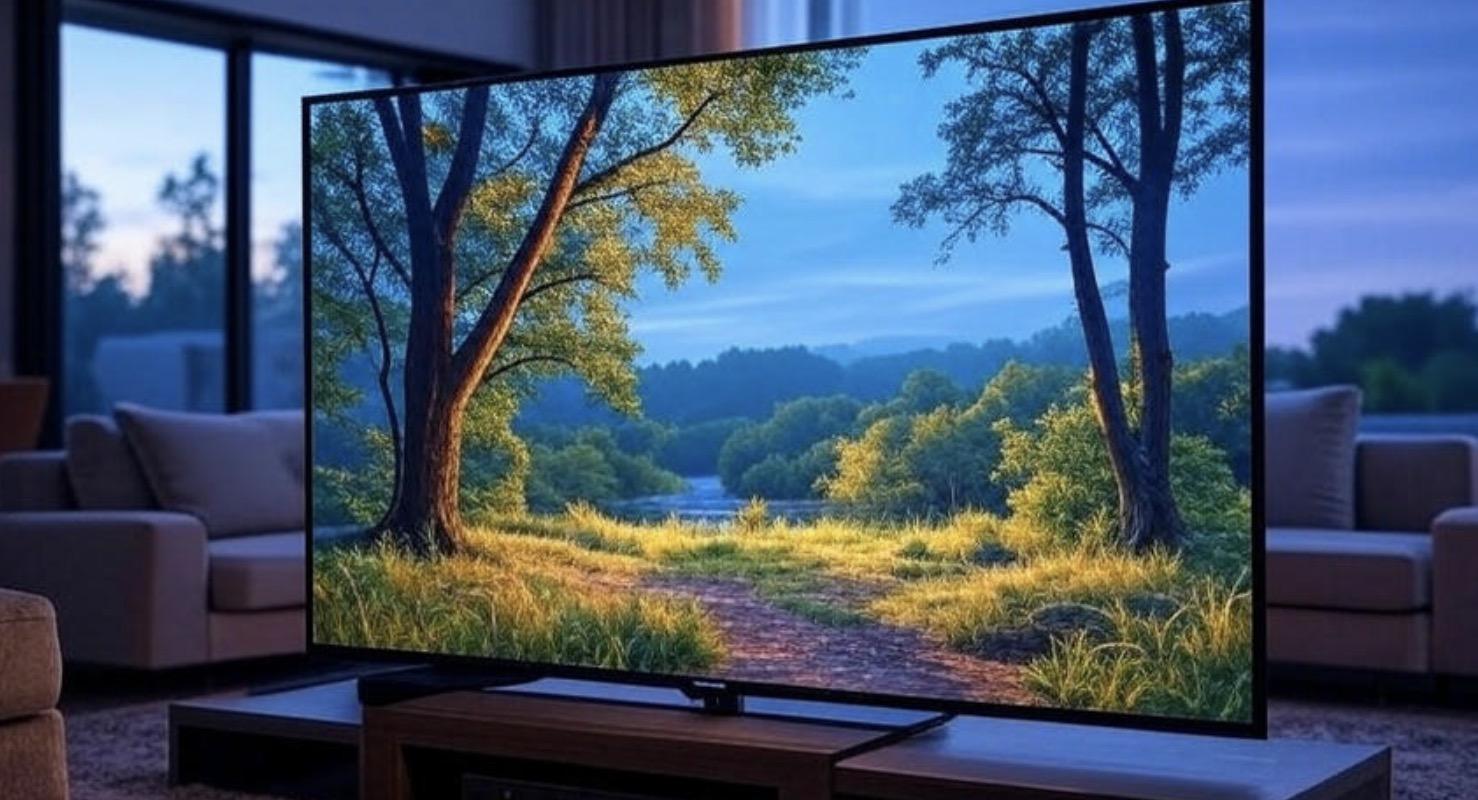
Discover the best 55-inch tv, QLED and Mini LED TVs in India for 2025. Compare OLED vs. QLED, 120Hz vs. 60Hz, Dolby Vision, and more for gaming, movies, and sports. Find top budget and premium TVs under ₹50,000 Rupees and beyond.
Looking For The Best 55-inch TV in 2025?
This is Best 55-inch TV buying guide breaks down OLED vs. QLED, mini LED vs. QLED, and refresh rates (120Hz vs. 60Hz) to help you choose the right TV. Whether you need the best TV for gaming, movies, or sports, I compare Dolby Vision vs. HDR10+, discuss smart TV operating systems, and reveal the best budget and premium 55-inch TVs in India for Netflix, PlayStation 5, and more. Check Another article on “11 Best 65-Inch & 75-Inch Best TVs in India (2025): From Budget to Premium“.
If you’re tight on budget, go for an LED TV, which gives a good enough picture quality at a lower price point. If budget is not a concern, go for an OLED TV, which offers the best picture quality, colours, and off-angle viewing.
Understand Capabilities Of The Best 55-inch TVs
Understand what capabilities you should care about and what you can ignore. I’ll explain the details in subsequent sections as well.
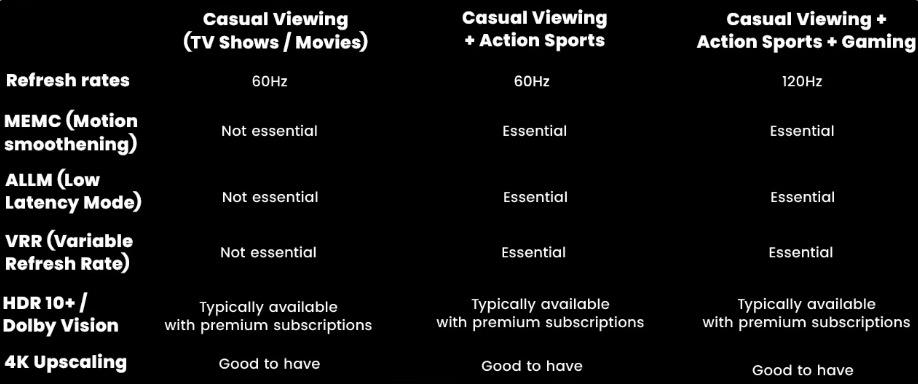
If you’re only keen on casual viewing and sports, then a 60-Hz panel is good enough for you. 4K HDR 10+ Dolby Vision generally works only with the top and premium plans of your streaming Subscription Service, like Netflix and Hotstar.
So, unless you’re subscribed to a Premium plan, buying a high specification may not be useful for you.
Audio Quality Of The Best 55-inch TVs
Audio quality in TV is generally poor, so you would benefit by supplementing it with a soundbar or a home theatre system for a better immersive experience. If you use your TV in Darker rooms, a mini LED TV is a better option for you as it is optimised for contrast, but if you use the TV in brighter rooms, a QLED TV is a better option for you as it is optimised for brightness. I’ve included both of these variants in today’s comparison.
Picture Quality, Audio Quality and Usability

Three things determine the quality of a TV: picture quality, audio quality, and usability. The picture quality is available in several different formats: HDR10, HDR10+, and Dolby Vision.
Because HDR10+ and Dolby Vision use Dynamic metadata, the quality is much better. Since Dolby Vision is a licensed format, many TVs, including many models from top Brands like Samsung, LG, and Sony, do not support Dolby Vision.
Understanding The Refresh Rate (60Hz vs. 120Hz)
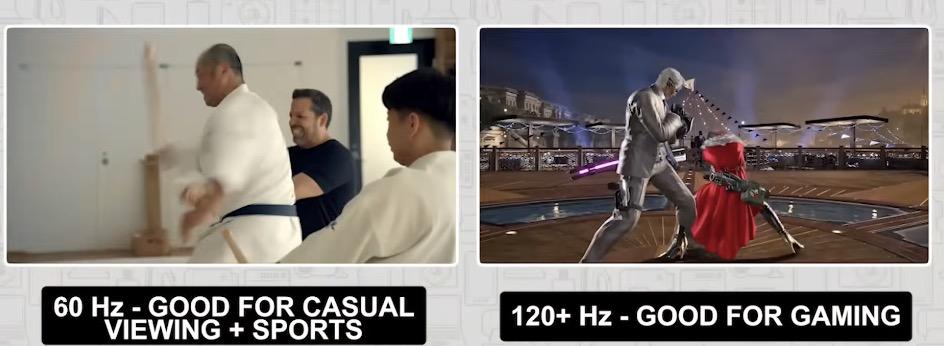
A higher refresh rate which is measured in Hertz, helps to reduce motion blur and provide a smoother visual experience in very fast-paced scenes, that also depends on the type of content you would like to consume, for example if you watch cricket frequently, the recent Champions Trophy was streamed in 50 frames per second or FPS in short which a 60 HZ TV can stream well. Most movies and documentaries are at 24 frames per second to give you a cinematic experience, which a 60 HZ TV can stream well.

If you watch Formula 1 frequently, that is also streamed at 60 FPS. Again, a 60 HZ TV can stream well. Action, sports, or extreme sports and fast games are generally streamed at a higher resolution, the only scenario where a 120 HZ TV is beneficial for you.
In general, we would want the frame rate of the content, which is measured in FPS, to be as close as possible to the refresh rate of the TV, which is measured in hertz.
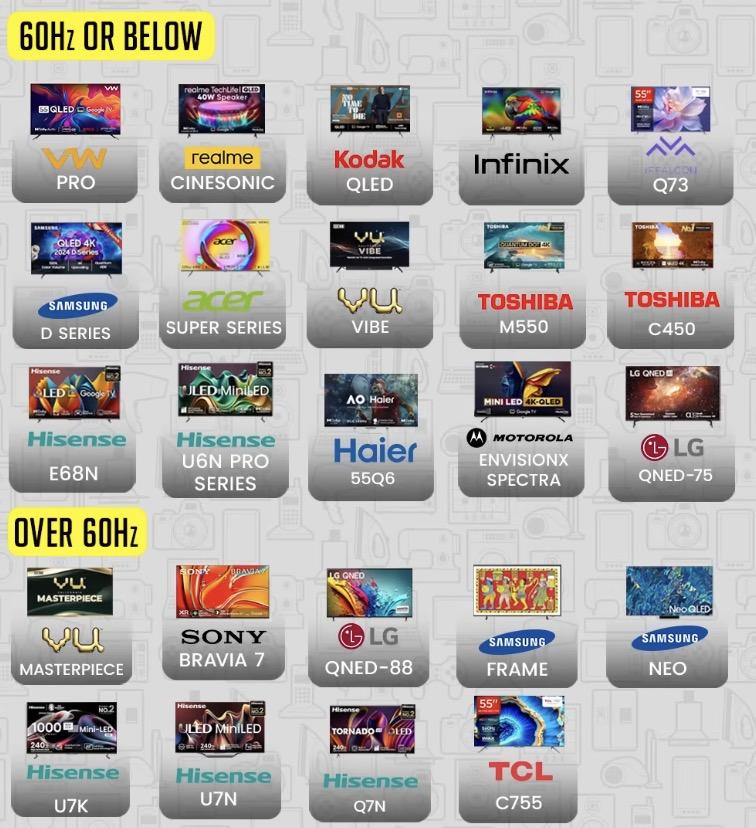
So now that we understand this you can see that most budget and mid-range TV are at 60 HZ and premium TVs are higher than 60 HZ refresh rate a related aspect that determines picture quality is the motion estimation and motion compensation or MMC in short, which helps to reduce the motion blur in fastpac scenes to reduce the strain on the ice.
It does this by inserting additional frames between the original frames to give a smooth and clear experience. All TVs that we’ve compared include MMC.
Gaming TVs

If you are a hardcoded gamer, you probably already know that using a monitor is better for you as it gives you the best performance. For casual gamers or those who game on the TV occasionally, there are a few key things you need to look for in your TV.
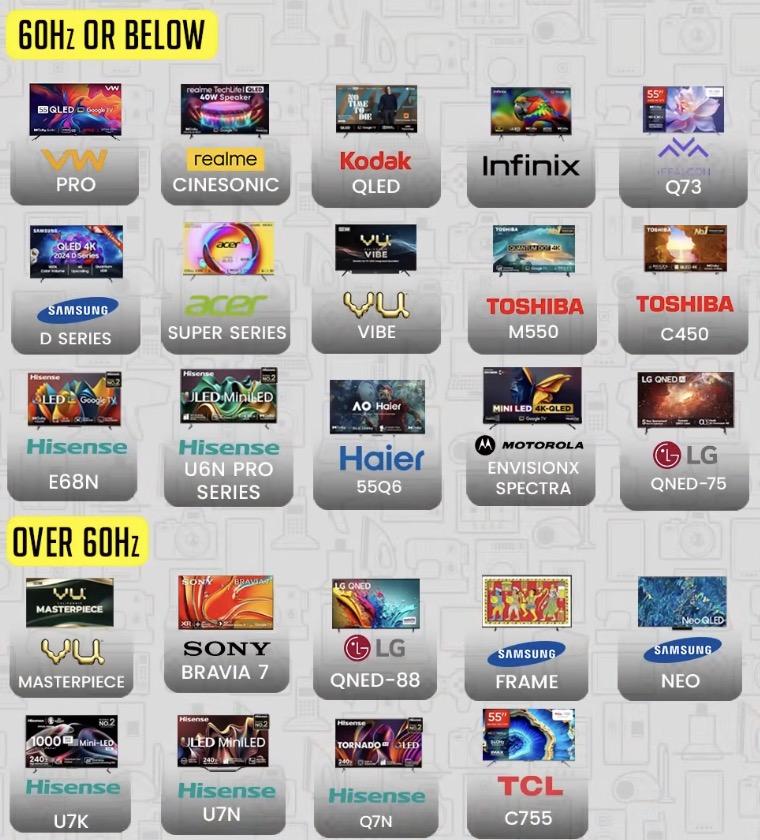
Depending on the type of games that you play, you may need a higher refresh rate of 120 HZ or upwards for fast-action games. For most casual gamers, 60 HZ is good enough.
Auto low latency mode, also called game mode or low lag mode in some TVs. Variable refresh rates and the support of the eARC HDMI port to connect your gaming consoles are also important aspects.
If you’re connecting your gaming console, make sure that the HDMI port is a 2.1 port or a 4K 120 HZ or a 4K 144 HZ port to support the higher frame rate of the content.
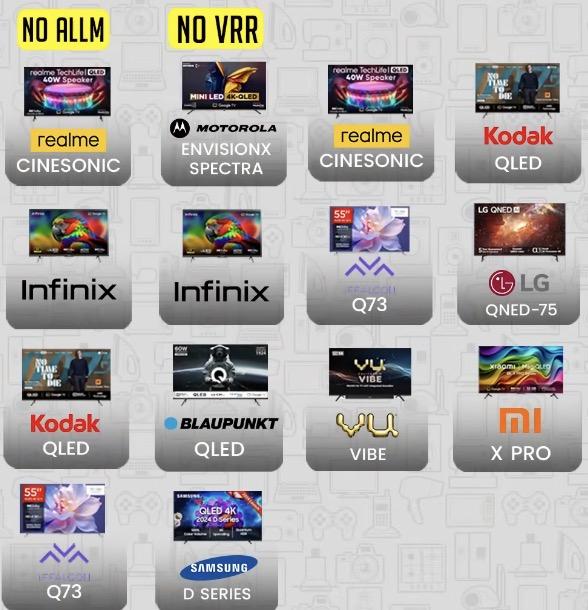
The Audio Auality
I’ve said it before, and I’ll say it again as TVs have gotten Slimmer and more advanced. The audio quality within the TV has not improved. So, adding a soundbar or a home theatre system to your TV is always a good idea.
Next to determine the sound quality and how immersive the audio experience is. We have to consider how many speakers and channels the TV has. Most TVs have only two speakers, except the Samsung Neo, which has four speakers. A subwoofer enhances the bass performance, which is generally built in case of TVs.
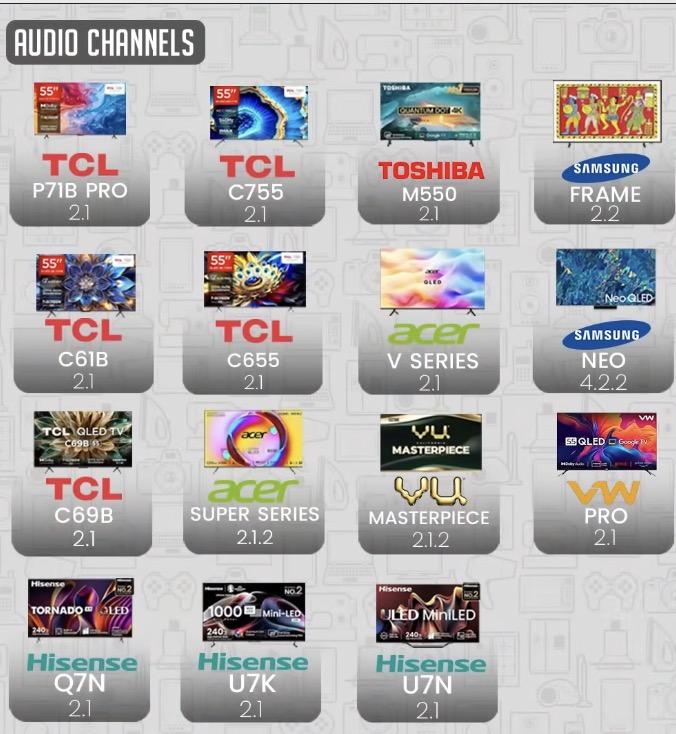
Samsung Frame and Samsung Neo have two subwoofers. Many mid-range TVs have one subwoofer, and most others do not have subwoofers. You can also consider if the TV has upward-firing speakers, which help to improve the audio experience. Only the Samsung Neo and the View Masterpiece have upward-firing speakers. These are useful, especially if Dolby Atmos is used.
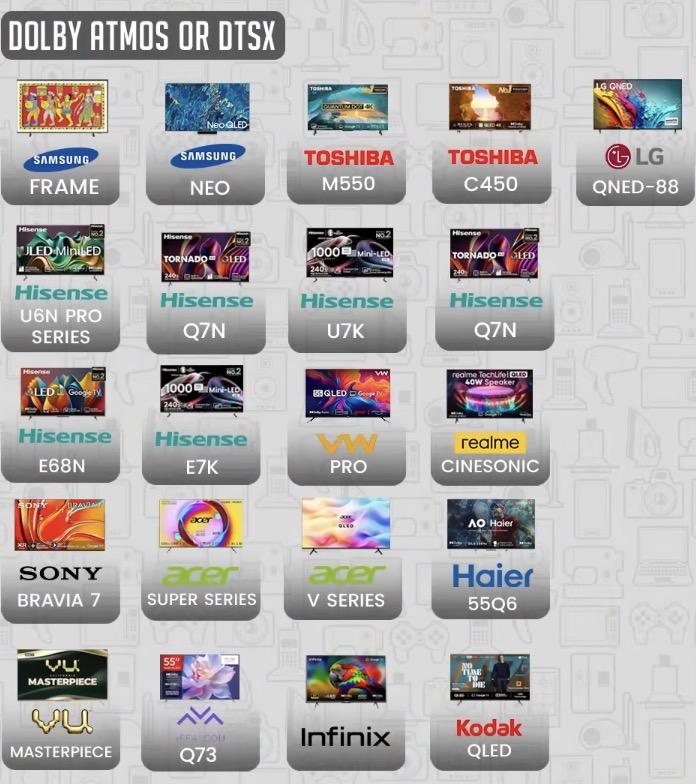
The technology used to compress the audio into different channels available on your TV for a better audio experience. Dolby Atmos or DTS-X are the best available, and only the TVs that you can check in the image below are supported.
I’ve personally used a TV without a soundbar and then added a soundbar; the difference is night and day. So, if you have the budget, consider adding a soundbar. If not, the Masterpiece or the Acer Super Series should be your preferred options in the budget section and the Samsung Frame or Samsung Neo in the premium section.

Discuss The Usability
This also becomes one of the most important aspects as we need to live with the TV for a long period, and we are in a time when delays are not tolerated. We are rarely okay with a slower user experience or frequent phasing of the display.
Samsung, LG and Hisense use proprietary operating systems of Tizen, WebOS and VIDAA, respectively.
These are optimised for a faster user experience, but many users complain about the non-intuitive nature of these operating systems. Which have significantly improved over the years. Popular apps that we mainly use in India are available in all of these operating systems.
Summarise:
If you want more apps and more personalised recommendations, go for a TV with a Google TV operating system. If you want a faster user experience, go for a TV with a proprietary operating system like Tizen, WebOS and VIDAA.
Connectivity In Tv
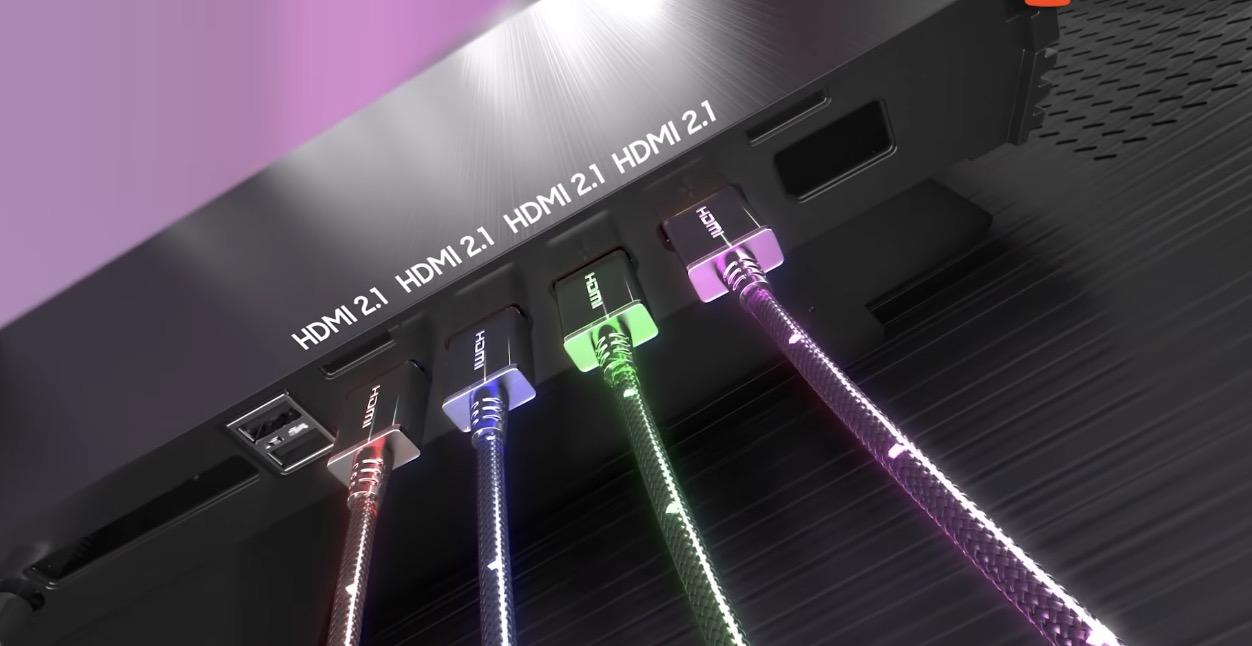
All TVs compared have an ER HDMI port, which is useful for connecting Soundbars, home theatre systems and gaming consoles. They also have multiple HDMI and USB ports to connect other storage and entertainment devices, as well as support Dual Band Wi-Fi.
If you are an Apple user, we all know how difficult it is to cast to a TV using our phones. The TVs you see in the image claim to support casting using Apple AirPlay.
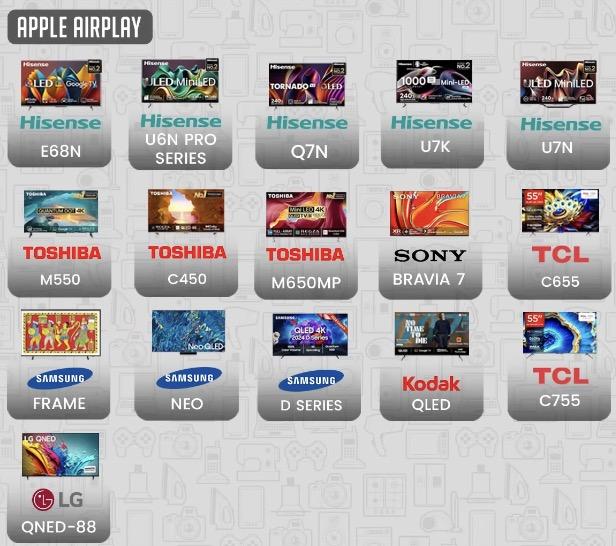
The Warranty And The Pricing
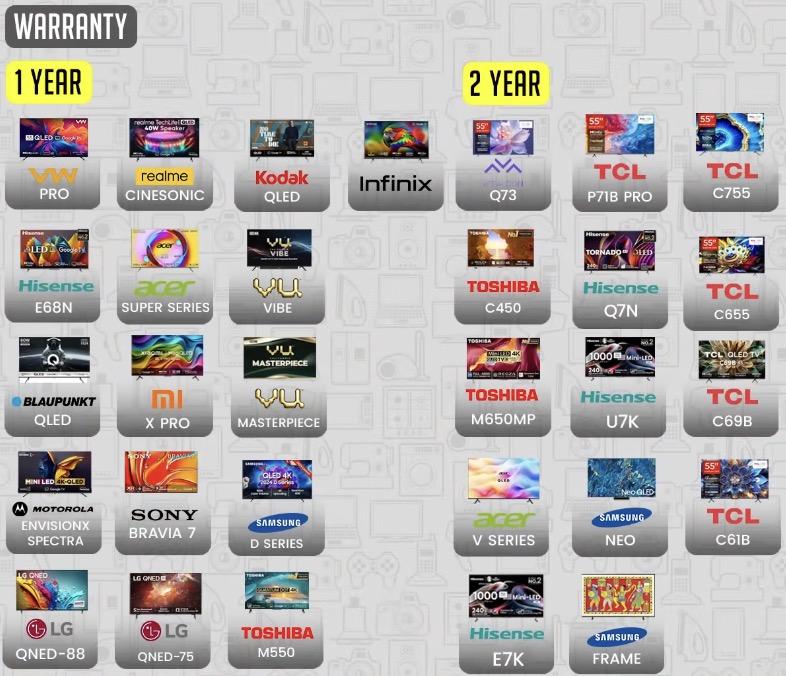
Warranty in general is one year with TCL, Hisense, Toshiba mini LED and some higher price models of Samsung giving a 2-year warranty. Hisense mini LED TVs and the Vu Vibe do come with a 3-year warranty.
Serviceability
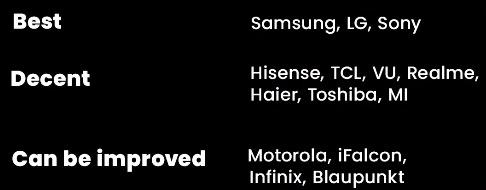
Serviceability is an issue with most budget TVs. If serviceability is the main buying criterion for you, buying a premium TV from Samsung, Sony, or LG would be ideal. Pricing varies based on a couple of things. LG, Samsung, and Sony, which are premium brands, are priced higher.
The second thing is the technology used. Mini LEDs are more expensive than QLEDs. The third is the picture quality, the presence of Dolby Vision, HDR10+ higher refresh rate all come at a higher price, whether you want it or not.
Gaming features like VRR, ALLM and MEMC, higher refresh rates again all command a higher price. So select one if only if you need these features.
Now that we understand how to shortlist the TV based on your TV viewing patterns, let’s get to my recommendations for the best 55-inch TVs in 2025.
Best 55-inch QLED TV Budget Under 50k
The best price-to-value in the 55-inch segment comes at a budget between 40k to 50k for a QLED TV. I have two recommendations for you here, both are useful for casual viewing and casual gaming as well.
The VU Masterpiece QLED TV
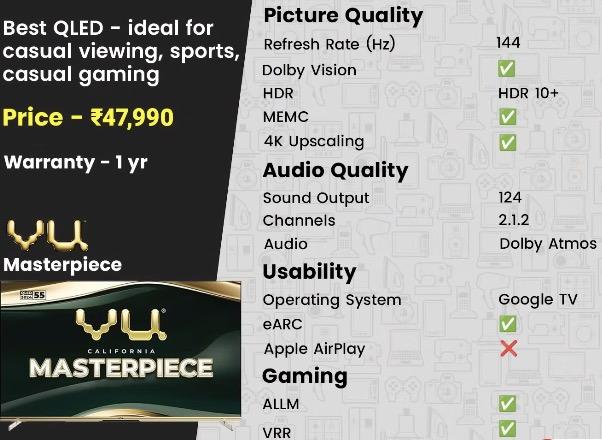
This product is always in and out of stock, so if you prefer this product, you may want to put an alert on its availability. The View Masterpiece 4K QLED TV has a 144 Hz refresh rate for smooth motion.
HDMI 2.1 for gaming and Dolby Vision, as well as HDR 10+ for vibrant visuals. It has seven speakers with 124 watts output, including two masters, four tweeters and an inbuilt subwoofer. It does use Google TV and has a wide range of apps. The gold frame adds a premium touch to it as well.
The Hisense Q7N QLED TV
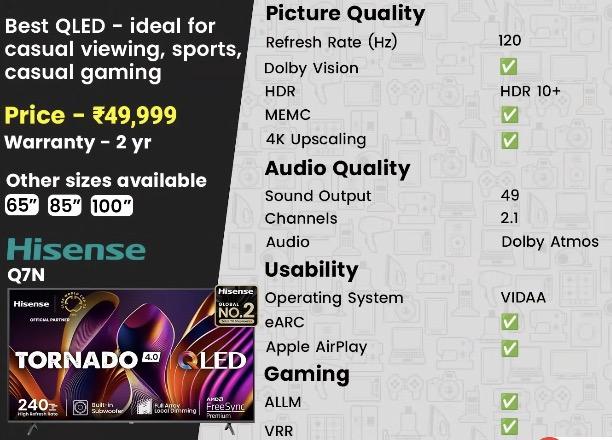
This 4K QLED TV has a 120 HZ refresh rate, a Dolby Vision IQ HDR 10+ and local dimming with 32 zones for stunning visuals. It does include the VIDAA OS, which includes built-in Alexa, AirPlay 2, and top streaming apps, with 400 nits brightness.
AI picture quality and a 2-year warranty, it is a good choice for immersive entertainment. The only notable con is that upscaling is not very great, so if you’re using it for cable TV or lower resolution content, upscaling would not be great.
Best 55-inch QLED TV Budget under 40k
The VU Vibe QLED TV
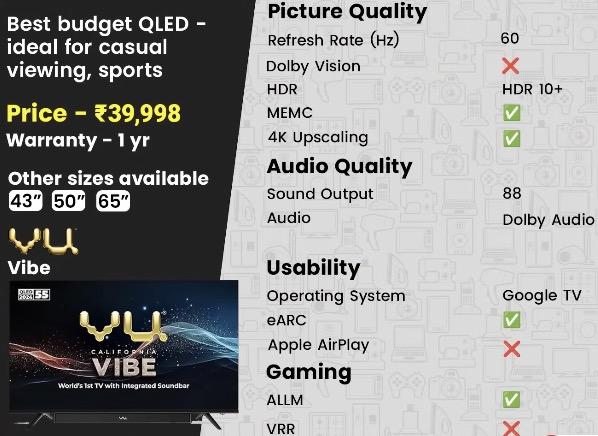
This is the only TV that includes an integrated Soundbar, solving one of the main problems of TVs these days, the audio. It does not, however, support the gold standard in audio, the Dolby Atmos, with a 60 HZ refresh rate.
it does support HDR10 format but does not support Dolby Vision, but like I said earlier Dolby vision is only available in premium tiers of your streaming subscriptions, so not relevant for a budget TV segment.
It was surprising to see users praise the service of view in smaller towns as well. So, VU has better service than most other budget TVs. Overall, it’s a great value for a budget.
The Hisense E68N QLED TV
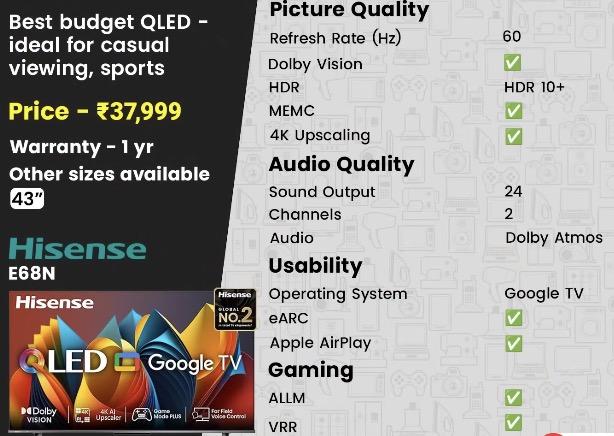
The Hisense E68N with similar capabilities in terms of picture quality to the VU Vibe. It additionally supports Dolby Vision. While the picture quality of this TV is praised by most users, many users have had issues with usability, like a slow UI or not remembering settings.
Best Premium QLED TVs
The best premium TVs which is useful for casual viewing and gaming.
The LG QNED-75 OLED TV
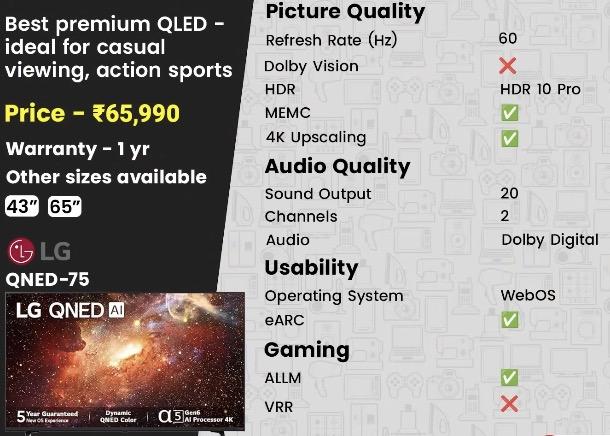
The LG QNED-75 is a premium TV at a lower budget than most other premium TVs, as it is missing Dolby Vision and Dolby Atmos.
It has the WebOS operating system with a built-in Alexa, Google Assistant and Apple AirPlay, providing a good user experience.
The audio quality is not great, only a 20-Watt output speaker with two speakers, with Dolby Digital only. So, you may need an extra sound bar for better audio quality.
The Samsung Frame OLED TV

The Samsung frame with a 100 HZ refresh rate, HDMI 2.1 port, HDR 10+ and support for ALLM and VRR. It is also ideal for Avid gaming. The Samsung frame TV can sit flush with your wall when mounted and can convert into a frame to display photos when it is not in use. It also has a matte display to enhance the viewing experience, and it has better Aesthetics.
Best Mini LED TVs
If you use your TV in dark rooms, like in home theatres. Mini LEDs give you a better picture quality and contrast compared to QLEDs in dark rooms. The best mini LED TVs since they have higher refresh rates and other capabilities suitable for gaming, they can be used by Avid Gamers too.
The Hisense U7K Mini-LED TV
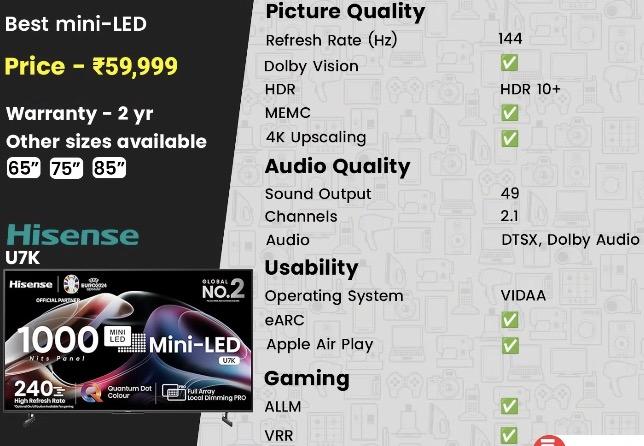
Hisense has a newer version of this, the Hisense U7N, with minimal difference, but for about 10,000 more, and 240 local dimming zones. The picture quality of this TV is outstanding, with two HDMI 2.1 ports and support for ALLM and VRR. This can be ideal for Avid Gamers, too.
The TCL C755 Mini LED TV
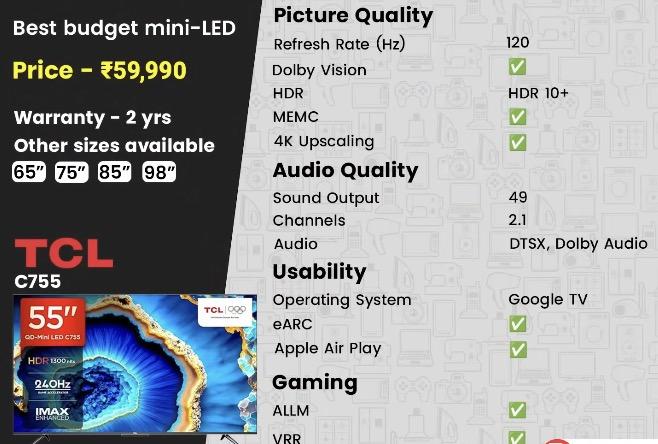
This TV supports Dolby Vision, has a high 1300 nits brightness, HDR 10+ and a high refresh rate, support for ALLM and VRR as well.
So it is good for watching Fast Action Sports and for Avid gaming as well, in addition to Casual viewing.
Service; however, it seems to be an issue for this brand of TVs, and some users have complained about the UI being buggy and unresponsive.
The premium mini LED segment
The Sony Bravia-7 Mini-LED
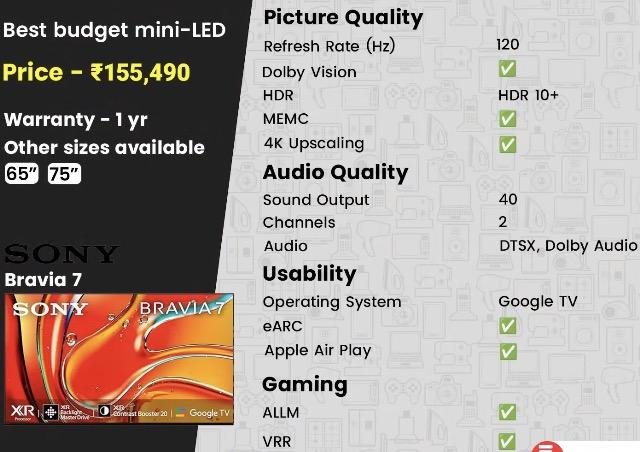
The Sony Bravia 7, which comes at almost a 2 and 1/2 to 3x price point compared to the other two. Unlike most other Sony TVs, this does support Dolby Vision as well. Overall, a great TV.
The only con highlighted by users is that it only has two HDMI 2.1 ports, and one of them is ER, so it is limited in connectivity for multiple gaming consoles and Soundbar systems.
Summary: This comprehensive guide explores the best 55-inch TVs in India for 2025, comparing QLED and Mini LED technologies for various use cases like gaming, movies, and sports. It breaks down key factors such as picture quality (OLED vs. QLED, HDR10+ vs. Dolby Vision), refresh rates (60Hz vs. 120Hz), audio quality, and smart TV operating systems (Tizen, WebOS, Google TV).
The article highlights budget-friendly options like the Vu Masterpiece and Hisense Q7N (under ₹50,000) and premium picks like the Samsung Frame and Sony Bravia 7, offering recommendations for casual viewers, gamers, and home theatre enthusiasts. It also covers connectivity, warranty, and serviceability, helping readers choose the ideal TV for their needs.
If you found this article useful, share this article and leave a comment below that trusts us with their decision-making. Thank you for visiting our website.
Disclaimer: Some links are affiliate links, which may earn me a small commission at no extra cost to you. 😊 Check: Affiliate Disclosure Page. and check our another social media acocunt: Click Here.
